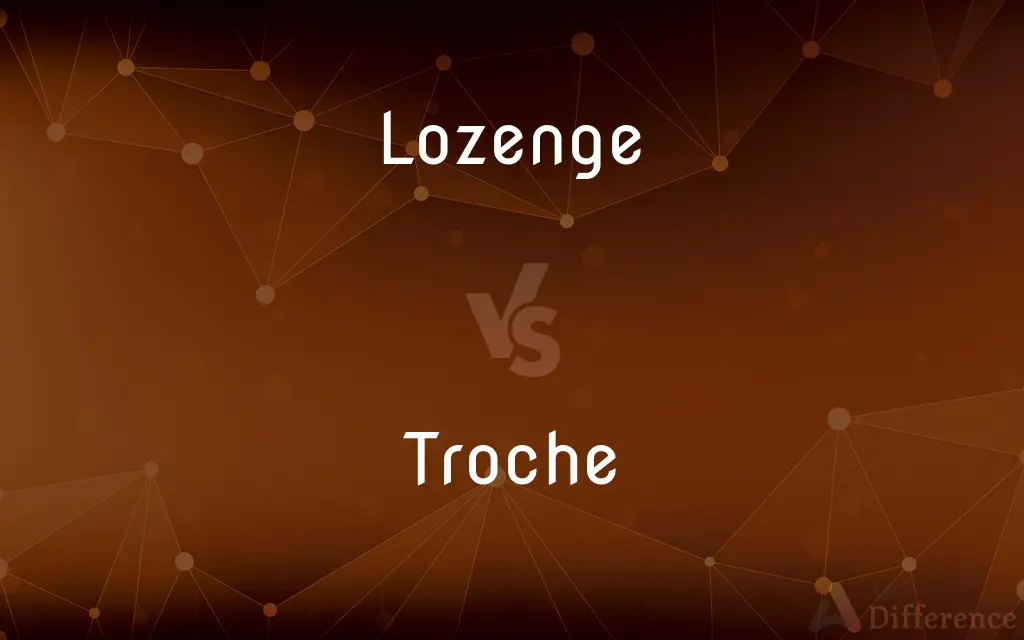Lozenge vs. Troche — What's the Difference?
By Tayyaba Rehman & Urooj Arif — Updated on April 29, 2024
A lozenge is a small, flavored medicated tablet intended to dissolve slowly in the mouth to soothe throat discomfort, while a troche is a type of lozenge specifically used for delivering medication through the mucous membrane of the mouth.

Difference Between Lozenge and Troche
Table of Contents
ADVERTISEMENT
Key Differences
Lozenges are commonly used to relieve symptoms of sore throats, coughs, or nasal congestion. They are designed to dissolve slowly in the mouth, releasing medication gradually. On the other hand, troches are a specialized form of lozenge used more specifically in medical treatments, such as hormone therapies or antifungal medications, and are designed to ensure that the medication is absorbed directly into the bloodstream through the mucous membranes.
Lozenges are available over the counter and are often used for mild throat irritation or dryness. They come in various flavors and may contain ingredients like menthol, eucalyptus, or honey. Whereas troches might require a prescription and are formulated to deliver a specific dosage of medication, making them part of a targeted therapy.
The composition of lozenges is generally geared towards soothing irritation with mild astringent or antiseptic properties. This makes them suitable for general use by the public without the need for medical supervision. In contrast, troches can contain potent drugs and are therefore used under medical advice for conditions such as yeast infections or hormone replacement therapy.
While lozenges are typically used for relief from symptoms of colds or allergies, troches are employed in more clinical settings, where precise dosing and specific drug delivery are crucial. This difference underlines their use in different contexts of health care.
The method of use between the two is quite similar—both are held in the mouth until they dissolve. However, the intention behind their use highlights the primary distinction: lozenges for symptom relief in everyday ailments and troches for specific, often more serious, medical conditions.
ADVERTISEMENT
Comparison Chart
Primary Use
Relief of throat discomfort and coughs
Delivery of medication for specific treatments
Availability
Over-the-counter
Typically prescription-based
Medicinal Ingredients
Mild astringents, antiseptics, flavorings
Potent drugs, including hormones and antifungals
Method of Use
Dissolve slowly in the mouth
Dissolve slowly in the mouth for mucosal absorption
Typical Users
General public
Patients under medical supervision
Compare with Definitions
Lozenge
Can be bought without a prescription.
I picked up a pack of lozenges from the drugstore.
Troche
A type of medicated lozenge used for specific medical treatments.
The doctor prescribed antifungal troches for his oral thrush.
Lozenge
Used for temporary relief of minor throat irritation.
Lozenges are my go-to remedy for dryness caused by allergies.
Troche
Primarily used under medical supervision.
His treatment included troches, monitored by his healthcare provider.
Lozenge
Available in various flavors and formulations.
She prefers citrus lozenges because they taste better.
Troche
Designed for absorption through the mouth’s mucous membrane.
Hormone replacement therapy sometimes involves the use of troches.
Lozenge
Often contains ingredients like menthol for cooling relief.
The menthol lozenges provided quick relief from my cough.
Troche
Requires a prescription for use.
She received a prescription for troches to manage her condition.
Lozenge
A small medicated tablet designed to dissolve slowly in the mouth to soothe the throat.
I took a honey-flavored lozenge to ease my sore throat.
Troche
Used for delivering a precise dose of medication.
Each troche contains a specific amount of medication for consistent dosing.
Lozenge
A lozenge ( ), ◊ – often referred to as a diamond – is a form of rhombus. The definition of lozenge is not strictly fixed, and it is sometimes used simply as a synonym (from the French: losange) for rhombus.
Troche
For the medicinal lozenge, see Pastille and Throat lozenge. For the form of poetic meter, see trochee.
Lozenge
A small, medicated candy intended to be dissolved slowly in the mouth to lubricate and soothe irritated tissues of the throat.
Troche
A small, circular medicinal lozenge; a pastille.
Lozenge
A four-sided planar figure with a diamondlike shape; a rhombus that is not a square.
Troche
A lozenge; a cough drop.
Lozenge
Something having this shape, especially a heraldic device.
Troche
A medicinal tablet or lozenge; strictly, one of circular form.
Lozenge
A quadrilateral with sides of equal length (rhombus), having two acute and two obtuse angles.
Troche
A medicated lozenge used to soothe the throat
Lozenge
A small tablet (originally diamond-shaped) or medicated sweet used to ease a sore throat.
Lozenge
(transitive) To form into the shape of a lozenge.
Lozenge
(transitive) To mark or emblazon with a lozenge.
Lozenge
A diamond-shaped figure usually with the upper and lower angles slightly acute, borne upon a shield or escutcheon. Cf. Fusil.
Lozenge
A figure with four equal sides, having two acute and two obtuse angles; a rhomb.
Lozenge
Anything in the form of lozenge.
Lozenge
A small cake of sugar and starch, flavored, and often medicated. - originally in the form of a lozenge.
Lozenge
A small aromatic or medicated candy
Lozenge
A dose of medicine in the form of a small pellet
Common Curiosities
What are lozenges used for?
Lozenges are used to soothe and relieve symptoms of sore throats, coughs, and nasal congestion.
Can anyone use troches?
Troches should be used under medical supervision, as they contain potent medications for specific treatments.
How do troches differ from regular lozenges?
Troches are a specialized type of lozenge designed for delivering medication through the mucous membranes, often requiring a prescription.
Can troches be used for anything other than medical treatments?
Troches are primarily used for medical purposes and should be used according to a doctor's prescription.
Are lozenges effective for treating infections?
While lozenges can provide symptomatic relief, they are not intended to treat infections unless they contain specific antimicrobial agents.
What should I consider before using a troche?
Consult a healthcare provider to ensure the troche is appropriate for your condition and to understand the correct usage.
Are there any risks associated with troches?
Troches may have side effects or interact with other medications, so it’s crucial to use them as directed by a healthcare professional.
How long does it take for a lozenge to work?
A lozenge begins to work as it dissolves, which can provide relief within minutes.
Do lozenges have any side effects?
Lozenges may cause minor side effects like mouth irritation or increased salivation but are generally safe when used as directed.
How often can I take lozenges?
Follow the package instructions or consult a healthcare provider for guidance on how often you can take lozenges.
Can children use lozenges?
Yes, there are lozenges specifically formulated for children, but it’s important to choose the appropriate type and strength.
Can I make lozenges at home?
Homemade lozenges can be made for general throat soothing, but they will not contain the same medicinal properties as commercial products.
Are troches available in different flavors?
Yes, troches may come in different flavors to make them more palatable.
What makes troches different in terms of ingredient potency?
Troches typically contain higher concentrations of active ingredients to ensure effective medication delivery through mucosal absorption.
Is it safe to use lozenges or troches during pregnancy?
Always consult a healthcare provider before using any medication, including lozenges or troches, during pregnancy.
Share Your Discovery

Previous Comparison
Parry vs. Block
Next Comparison
Ode vs. PoemAuthor Spotlight
Written by
Tayyaba RehmanTayyaba Rehman is a distinguished writer, currently serving as a primary contributor to askdifference.com. As a researcher in semantics and etymology, Tayyaba's passion for the complexity of languages and their distinctions has found a perfect home on the platform. Tayyaba delves into the intricacies of language, distinguishing between commonly confused words and phrases, thereby providing clarity for readers worldwide.
Co-written by
Urooj ArifUrooj is a skilled content writer at Ask Difference, known for her exceptional ability to simplify complex topics into engaging and informative content. With a passion for research and a flair for clear, concise writing, she consistently delivers articles that resonate with our diverse audience.
















































